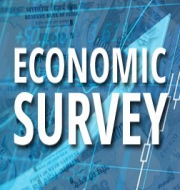Highlights of Economic Survey 2017-18
Union finance Minister Arun Jaitley tabled the Economic Survey 2017-18 in Parliament during 2018 budget session. The survey was authored by chief economic adviser in the finance ministry Arvind Subramanian. The survey projects economy to grow in the range of 7% to 7.50% in the next fiscal year 2018-19 in the post-demonetisation year. Suvey 2017-18 was in pink colour to highlight gender issues.
Key Highlights of Survey
Growth Forecast: The real GDP growth projections for 2017-18 is expected to be around 6.75%, which is further expected to reach to 7-7.5% in 2018-19 driven by major reforms initiated by the government. There was reversal of declining trend of GDP growth in second quarter of 2017-18. The growth during this period was led by industry sector. Agriculture, industry and services sectors are expected to grow at the rate of 2.1%, 4.4%, and 8.3% respectively in 2017-18.
Fiscal discipline: The fiscal deficit as percentage to GDP to remain stable at 3.2%, indicating that government’s priority still lies in fiscal consolidation.
Inflation: Lower CPI inflation average to 3.33% will be seen but higher WPI Inflation average to 2.9% in 2017-18.
Exports: Growth of exports rebounded into positive one during 2016-17 and expected to grow faster in 2017-18 to 12.1% after remaining in negative territory for a couple of years.
Forex reserves: India can be rated as among the best performing economies in the world with its foreign exchange reserves shooting to $409.4 billion.
Goods and Services Tax (GST): It has given new perceptive of Indian economy and new data on indirect taxation has emerged. There has been a 50% increase in number of indirect taxpayers.
India’s formal sector: The formal non-farm payroll is substantially greater than currently believed to be. When formality was defined in terms of social security provisions like EPFO/ESIC, then the formal sector payroll was found to be about 31% of the non-agricultural work force. When it was defined in terms of being part of the GST net, then such formal sector payroll share was found to be 53%.
International exports of states: For the first time in India’s history, data on the international exports of states was dwelled in Economic Survey. It indicates strong correlation between export performance and states’ standard of living. States exporting internationally and trading with other states were found to be richer. Thus, such correlation is stronger between prosperity and international trade.
Firms and Exports: India’s exports are unusual as largest firms account for a much smaller share of exports than in other comparable countries. Top 1% of Indian firms account only for 38% of exports unlike in other countries where they account for substantially greater share – (72%, 68%, 67% and 55% in Brazil, Germany, Mexico and US respectively). Such tendencies were also found to be true for top 5-10% of the Indian companies.
Desire for male child: Indian society exhibits a strong desire for male child. It pointed out that most parents continued to have children until they get number of sons. Various scenarios leading to skewed sex ratios have been mentioned in survey and it also gave comparison on sex ratio by birth between India and Indonesia.
Tax disputes: Tax departments in India have gone in for contesting against in several tax disputes but with low success rate which is below 30%. About 66% of pending cases accounted for only 1.8% of value at stake. It further stated that 0.2% of cases accounted for 56% of value at stake.
Impact of climate change on agricultural yields: Extreme temperature increases and deficiency in rainfall have due to climate change and its impact on agricultural yields has been captured in survey. The impact was found to be twice as large in un-irrigated areas as in irrigated ones.
Month: Current Affairs - January, 2018


